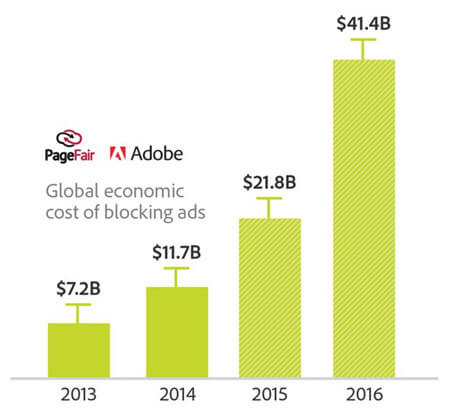Many online users are down with ad nausea. This sounds like your (potential) customers are actively finding ways to soothe their discomfort, and turning to ad blocking software for help to avoid your ads on their browsers.
And ad blocking software is on the rise. According to The 2015 Ad Blocking Report by Adobe and PageFair, the number of people who use ad-blocking software worldwide has increased by 41% to 198 million. A similar study by ClarityRay found that nearly 10% of all ad impressions get ad-blocked. In fact, tech sites average at 17.79%, followed by news (15.58%) and culture (9.94%). While these figures are much lower on mobile devices, ad blocking is starting to rise with the presence of ad-blocking apps and new default browser settings on Apple and Android devices. All in all, the studies point to the same conclusion – the use of ad blocking software is rising and will continue to increase further.
What does ad blocking mean and what does this mean for you?
Ad blocking software is installed as plug-ins or browser extensions and is designed to prevent advertisements from appearing on the web pages. The two main methods ad blocking software uses to block ads are as following:
- Ad blocking software blocks the communication with the ad servers, so that the page cannot find the resource to retrieve the ad when loading.
- Ad blocking software blocks the HTML element that is identified as an ad.
This way, ad blocking software disables all ads, including your ads. The amount of time, effort and money you are investing to reach your customers thereby go to naught in the presence of ad blocking. (This is unless of course your ads are added to a whitelist that enables these ads to be shown anyway – or the ad blockers are unable to identify that the server is an ad server, or that the ad is an ad.)
Why is ad blocking a problem for you and your marketing?
Content is commonly accompanied by ads both offline and online. The ads finance the media that carries this content, be it offline newspapers and magazines, or online news sites, blogs, forums and other websites, in order to make high quality content affordable. It is also the responsibility of the media to deliver relevant ads to their readers.
In the online marketing realm, publishers do that job. They deliver ads from advertisers like you to their website visitors and earn revenue from it. However, with ad blocking software in place, their ads do not appear and they therefore lose this potential income. Globally, the amount of blocked revenue due to ad block usage is estimated to be USD 22 billion in 2015, and expected to reach USD 41.4 billion in 2016.
Apart from directly hurting the existence of publishers, users of ad blockers are also inadvertently hurting you, the advertising industry at large and the quality of content that is being delivered on the Internet. Additionally, the blocking of ads will affect the accuracy of data collected from your website. As the data collected no longer paint the whole picture, it will generate unreliable reports and customer journey analyses, of which your data-driven decisions are based on.
Why are ad blockers growing in popularity?
Why are users starting to get ad nausea? Many studies have tried to get to the bottom of these and discovered that users are installing ad blocking software because of:
Annoying ads
Ads with no relevance to the users in poor format (e.g. pop-ups, blinking ads, ads that aren’t easy to close) and of poor taste lack value exchange and only make users frustrated. They end up just wanting to close all ads possible – and right away!
Poor load time
Depending on the size and number of ads on a page, loading the ads may slow down the website performance in total, causing an unpleasant user experience. This is usually more pronounced when it comes to mobile users as the ads may not be designed for smaller screens and it may even be costly for them to load the data on-the-go.
Uneasiness concerning personal data collection
Websites may have collected data from the users and thereby served specific ads according to what they have searched before, causing users to find this a little creepy and uncertain as to what other information may have been collected.
So, enough of self-pity in the online marketing industry – ad blocking software is not only being used because it’s easy to install. The root of the problem could actually be due to the poor execution of ads by marketers across this industry.
What can you and all marketers do?
It doesn’t matter if the fault of the poor ad experience lies in the advertiser due to its large size or in the publisher due to its poor placement. Users are equally likely to blame both the advertiser and the publisher. Marketers from both sides need to take several measurements to ensure they don’t manipulate the privilege they have to directly impact users.
Some marketers turn to alternative ad formats in the meantime, to minimise the effects of ad blocking. Some publishers use native ads (e.g. search ads, recommendation widgets, promoted listings and sponsored content) in order to reach their target group and protect their revenue. However, it is important to note that these are not necessarily completely immune to ad blocking.
Therefore, in the long term, marketers for both advertisers and publishers need to:
Put users back on the centre stage
If done correctly, the users that are viewing your ads are your potential customers, so don’t chase them away with annoying ads. Gather accurate data with first-party tracking solution and evaluate their behaviour. Listen to their needs. Keep their concerns at the top of your mind when developing digital strategies. What are they on your website for? How quick do they need the information they were looking for? What other interests do they have?
Educate today’s tech-savvy users
As users get more tech-savvy, it’s important to give them the information they need. Don’t be anonymous – let users know who you are and get their consent when collecting their information. Educate them wherever possible to reduce any possibility of suspicion and uncertainty.
Make ads additive to the experience
Users don’t want to be blasted with annoying ads, so if at all, ads need to of a high standard. If possible, the ads should be tailored and elegant and provide value to the users, be it in terms of information or entertainment. Some companies are looking into hiring graphic surgeons for constant optimization and fine-tuning of ads. There is even an uprising movement known as the Coalition for Better Ads (https://www.betterads.org/) with the aim to create an industry standard for ads of higher quality. With the right first-party tracking solution, you can also better cater your marketing activities according to the phase they are at in their decision-making process. This way you can value-add to their purchase experience.
At the end of the day, it is not just about monetising this one moment of interacting with the user but the long-term relationship the user has with the website, in order to benefit from the full customer lifetime value. The best long-term measure is a constant cycle of optimisation: Track with a 1st-party solution to collect accurate data for better analysis, evaluate your performance and alter the ads to the needs of your customers.




























